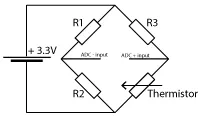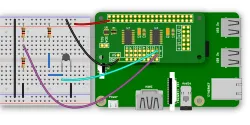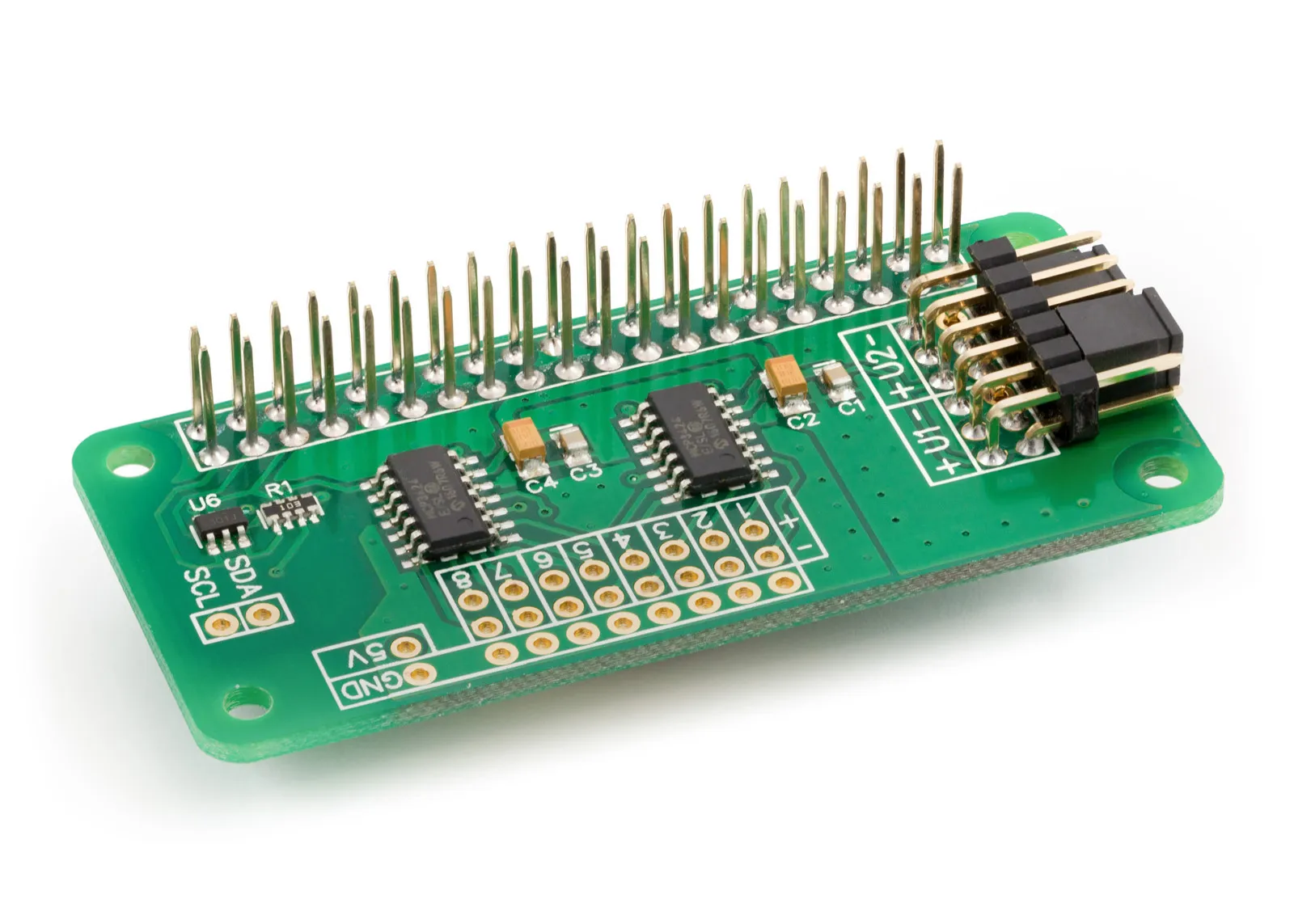This tutorial will use the ADC Differential Pi or DeltaSigma Pi with a Semitec103AT-11 NTC (Negative Temperature Coefficient) Thermistors 10kohm 1% to make a digital thermometer. You will need your Raspberry Pi, an ADC Differential Pi or DeltaSigma Pi, and a Semitec103AT-11 NTC.
We will use the AB Electronics Python library to talk to the ADC Differential Pi. To download the library, visit our Python Library and Demos knowledge base article.
You must enable I2C on your Raspberry Pi; see our other tutorial on i2c: I2C Part 2: Using I2C on the Raspberry Pi.
Parts Used:
Semitec103AT-11 NTC (Datasheet)
3 x 10K Resistor
Connecting Wire
Connecting the sensor and resistors to the ADC Differential Pi Plus
 If you haven't done so, install your ADC Differential Pi Plus onto the Raspberry Pi by connecting it to the GPIO header. Make sure your Raspberry Pi is turned off when you do this to minimise the risk of damaging the Raspberry Pi or the ADC Differential Pi Plus.
If you haven't done so, install your ADC Differential Pi Plus onto the Raspberry Pi by connecting it to the GPIO header. Make sure your Raspberry Pi is turned off when you do this to minimise the risk of damaging the Raspberry Pi or the ADC Differential Pi Plus.
This circuit uses a "Wheatstone bridge" to return a voltage dependent on the temperature sensor's resistance. Using this, we can then calculate the resistance and then the temperature.
On a breadboard, add the 3 x 10K resistors and the temperature sensor as shown on the circuit mock-up image (you can click to enlarge)
Connect the positive breadboard rail to 3.3V on the GPIO header.
Connect the GND breadboard rail to GND on the GPIO header.
Connect the ADC + input from the breadboard to the + channel on input 1 on the Differential Pi board.
Connect the ADC - input from the breadboard to the - channel on input 1 on the Differential Pi board.
 On the ADC Differential Pi, connect the negative inputs on channels 1, 2 and 3 to GND; this sets the ADC chips into the single-ended mode to measure between 0 and 2.048 volts.
On the ADC Differential Pi, connect the negative inputs on channels 1, 2 and 3 to GND; this sets the ADC chips into the single-ended mode to measure between 0 and 2.048 volts.
We will create a new Python program file for this tutorial called demo-demo-resistance-thermometer.py. You can use your favourite text editor to write the program. You can find a complete example of demo_resistance_thermometer.py in the ABElectronics_Python_Libraries/ADCDifferentialPi/demos/ folder.
At the top of your program, you must import the ADCDifferentialPi library and time library. We also add variables to hold the values related to the sensor data conversion.
#!/usr/bin/env python from ADCDifferentialPi import ADCDifferentialPi import time import os import math
The ADCDifferentialPi library is used for all communication with your ADC Differential Pi Plus; it gives you control over almost everything that can be done with the MCP3424 controller.
Next, we need to create an instance of the ADCDifferentialPi class and call it adc.
adc = ADCDifferentialPi(0x68, 0x69, 18)
0x68 and 0x69 are the I2C address for the ADC chips. If you have changed the address selection jumpers on your ADC Differential Pi Plus, you must change these numbers to match the new addresses.
Now we add variables which will be used to hold the default values of the resistors and thermometer values from the datasheet.
# the resistor values for the Wheatstone bridge are: resistor1 = 10000 resistor2 = 10000 resistor3 = 10000 # Input voltage voltin = 3.3 # Resistance thermometer values from datasheet bResistance = 3435 t25Resistance = 10000 # Constants t0 = 273.15; t25 = t0 + 25;
We need to create a new function to convert the voltage returned into the resistance using the following:
def calcResistance(voltage):
return (resistor2*resistor3 + resistor3* (resistor1+resistor2)*voltage / voltin )/ (resistor1- (resistor1+resistor2)*voltage / voltin)
We need to create a new function to convert the resistance into the temperature:
def calcTemp(resistance):
return 1 / ( (math.log(resistance / t25Resistance) / bResistance) + (1 / t25) ) - t0;
We need to loop the same commands over and over. This can be done with a simple while loop.
while True:
As True is always true, the while loop will continue until you exit the program with a Ctrl-C.
Now we read the voltage from the ADC channel and convert it to the values needed:
# read from adc channels and print to screen bridgeVoltage = adc.read_voltage(1) thermresistance = calcResistance(bridgeVoltage) temperature = calcTemp(thermresistance)
We must issue a clear command to clear the console for each read.
# clear the console
os.system('clear')
Next, we print the values to the screen.
# print values to screen
print("Bridge Voltage: %02f volts" % bridgeVoltage)
print("Resistance: %d ohms" % thermresistance)
print("Temperature: %.2fC" % temperature)
Using the time.sleep method, we add a 0.5 second delay before repeating the read.
time.sleep(0.5)
time.sleep takes one variable, a number representing the number of seconds to wait. 1 will make the program sleep for 1 second while 0.1 would wait for 100ms.
That is everything we need to make read from the Thermistor sensor using your ADC Differential Pi or Delta Sigma Pi; your program should now look like this.
#!/usr/bin/env python
from ADCDifferentialPi import ADCDifferentialPi
import time
import os
import math
"""
================================================
ABElectronics ADC Differential Pi 8-Channel ADC read Resistance thermometer
using a Wheatstone bridge.
This demo uses a Semitec NTC (Negative Temperature Coefficient) Thermistors
10kohm 1%, Manufacturer Part No: 103AT-11
Purchased from Mouser Electronics, Part No: 954-103AT-11
The circuit is connected to the + and - inputs on channel 7 on the
ADC Differential Pi. This can also be used on the Delta Sigma Pi
The Wheatstone bridge is comprised of three 10K resistors and the
Resistance thermometer
Version 1.0 Created 30/10/2015
Requires python3 smbus to be installed
run with: python3 demo_resistance_thermometer.py
================================================
Initialise the ADC device using the default addresses and 18 bit sample rate,
change this value if you have changed the address selection jumpers
Bit rate can be 12,14, 16 or 18
"""
adc = ADCDifferentialPi(0x68, 0x69, 18)
# the resistor values for the Wheatstone bridge are:
resistor1 = 10000
resistor2 = 10000
resistor3 = 10000
# Input voltage
voltin = 3.3
# Resistance thermometer values from datasheet
bResistance = 3435
t25Resistance = 10000
# Constants
t0 = 273.15;
t25 = t0 + 25;
def calcResistance(voltage):
return (resistor2*resistor3 + resistor3* (resistor1+resistor2)*voltage / voltin )/ (resistor1- (resistor1+resistor2)*voltage / voltin)
def calcTemp(resistance):
return 1 / ( (math.log(resistance / t25Resistance) / bResistance) + (1 / t25) ) - t0;
# loop forever reading the values and printing them to screen
while (True):
# read from adc channels and print to screen
bridgeVoltage = adc.read_voltage(1)
thermresistance = calcResistance(bridgeVoltage)
temperature = calcTemp(thermresistance)
# clear the console
os.system('clear')
# print values to screen
print("Bridge Voltage: %02f volts" % bridgeVoltage)
print("Resistance: %d ohms" % thermresistance)
print("Temperature: %.2fC" % temperature)
# wait 0.5 seconds before reading the pins again
time.sleep(0.5)
Save your program as "demo_resistance_thermometer.py" and run it in a command terminal using the following.
python3 demo_resistance_thermometer.py
You will now have a reading from your sensor on the console, which will repeat every 0.5 seconds.
(images created with Fritzing)
Note: documents in Portable Document Format (PDF) require Adobe Acrobat Reader 5.0 or higher to view, download Adobe Acrobat Reader or other PDF reading software for your computer or mobile device.

